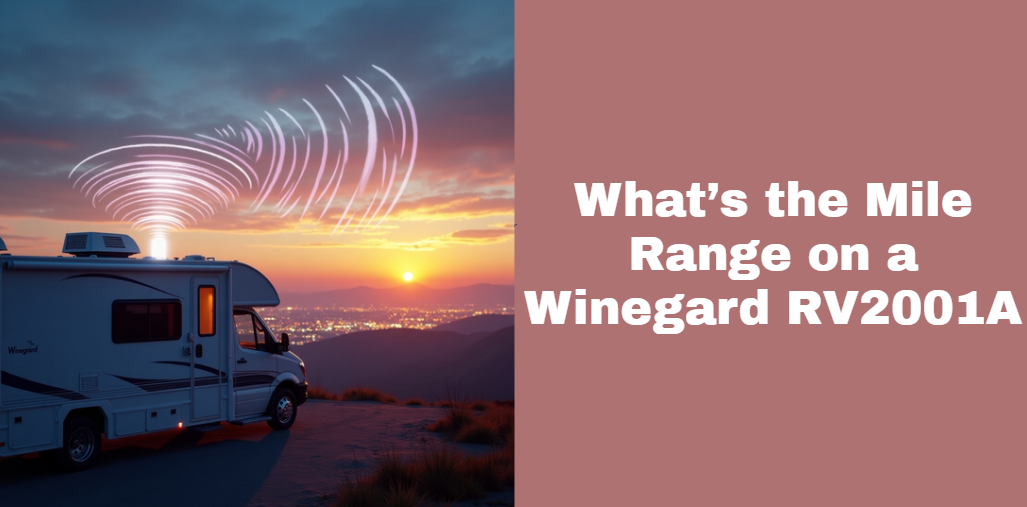What’s the Mile Range on a Winegard RV2001A? Full Guide for RV Travelers
When you’re traveling in an RV, staying connected to local TV broadcasts can make your journey more comfortable and enjoyable. One of the most talked-about devices for RV entertainment is the Winegard RV2001A antenna.
A common question many users ask is, “What’s the mile range on a Winegard RV2001A?” This guide explores the answer in-depth, breaking down its specifications, real-world performance, influencing factors, and how to get the most out of it.
Understanding the Winegard RV2001A
The Winegard RV2001A is an amplified, omnidirectional HDTV antenna specifically built for RVs. Its compact dome design makes it weather-resistant and easy to mount on an RV roof. It’s designed to capture VHF, UHF, and digital signals, allowing travelers to access free over-the-air channels without the need for a satellite subscription.
Unlike traditional directional antennas, which require manual adjustment to find the strongest signal, the RV2001A automatically receives signals from all directions. This makes it especially convenient for those who are constantly on the move.
Defining “Mile Range” in Antennas
Before diving into the specifics of the Winegard RV2001A, it’s essential to understand what “mile range” means. In antenna technology, mile range refers to the maximum distance at which an antenna can effectively receive a signal from a broadcasting tower. This range is not always fixed and can vary depending on several factors such as terrain, interference, and atmospheric conditions.
In other words, an antenna’s listed range is an estimate based on ideal conditions. The actual performance might differ depending on where and how the antenna is used.
Official Specifications of the Winegard RV2001A
Here are the technical details of the RV2001A antenna according to Winegard and trusted retailers:
| Specification | Detail |
|---|---|
| Model | Winegard RV2001A |
| Type | Omnidirectional Amplified Antenna |
| Designed For | Recreational Vehicles (RVs) |
| Supported Signals | VHF, UHF, Digital HDTV |
| Power Supply | 12V DC via wall-plate amplifier |
| Antenna Range | Up to 55 miles (manufacturer stated) |
| Dimensions | 12.4” diameter x 9.5” height |
| Weight | 2.4 lbs |
According to official specs, the RV2001A has a maximum range of 55 miles under ideal conditions. However, anecdotal user reviews suggest it can sometimes receive signals from as far as 60–75 miles, particularly in open terrain.
Real-World Performance
The theoretical range is only part of the story. In the real world, the performance of the Winegard RV2001A varies depending on where you’re parked and other environmental conditions.
Common observations from RV users include:
- Consistent signal in suburban and rural areas within 50 miles of major cities.
- Signal quality drops when parked near large metal structures or inside densely wooded areas.
- Better reception on flat, open land versus hilly or mountainous terrain.
- Some users have pulled in channels from towers as far as 70 miles away when parked at high elevations.
So, if you’re wondering “what’s the mile range on a Winegard RV2001A” in practical terms, the answer is: it typically performs best within 35–55 miles, with occasional success up to 75 miles depending on the surroundings.
Factors Affecting Signal Range
Several variables can influence how far your Winegard RV2001A can reach:
Terrain and Elevation
Flat and open land allows signals to travel farther. Mountains and valleys can block or reflect signals, reducing range.
Obstructions
Trees, buildings, and even other RVs nearby can interfere with signal reception.
Weather Conditions
Heavy rain, snow, or fog can weaken or scatter signals, reducing the antenna’s effective range.
Electronic Interference
Nearby power lines, mobile phones, and electronic devices might cause interference that affects signal clarity.
Broadcast Tower Power
The strength of the transmitting signal also matters. High-powered stations will reach farther than low-powered ones.
Tips to Maximize Antenna Range
Even with the best antenna, optimizing your setup can greatly impact performance. Here are some effective ways to boost your Winegard RV2001A’s range:
- Mount it as high as possible on the RV roof.
- Park in open areas, away from large obstructions.
- Use the included amplifier to strengthen weak signals.
- Scan for channels after every location change using your TV’s auto-tune feature.
- Use mobile apps like “TV Towers USA” or “Antenna Point” to locate nearby broadcasting stations.
These techniques help improve signal reception and ensure you’re getting the most out of your antenna.
Comparing the RV2001A to Other Antennas
Let’s see how the Winegard RV2001A stacks up against similar RV antennas:
| Antenna Model | Type | Max Range (Miles) | Requires Adjustment | Price Range |
|---|---|---|---|---|
| Winegard RV2001A | Omnidirectional | 55–75 (real-world) | No | $120–$160 |
| King OA8500 Jack | Directional | Up to 70 | Yes | $130–$180 |
| Winegard Rayzar Z1 | Directional | Up to 60 | Yes | $90–$130 |
| 1byone OmniPro | Omnidirectional | Up to 65 | No | $80–$100 |
The RV2001A offers a balanced combination of range, simplicity, and quality, making it a solid choice for most RV users who prefer a no-hassle solution.
Installation and Setup
Installing the RV2001A is a relatively simple process:
- Mount the antenna on the RV roof using the included hardware.
- Connect the coaxial cable from the antenna to the included power injector or wall-plate amplifier.
- Connect to your TV, then scan for channels.
- Verify signal strength and adjust RV position if needed.
Common mistakes to avoid:
- Installing the antenna too close to AC units or metal structures.
- Forgetting to power the amplifier.
- Not re-scanning for channels after changing locations.
Frequently Asked Questions (FAQs)
Q: What’s the mile range on a Winegard RV2001A in cities?
A: In urban environments with many obstructions, the range may drop to 30–40 miles.
Q: Can I use the RV2001A while the RV is moving?
A: Technically yes, but for best performance, use it when parked.
Q: Do I need a satellite with this antenna?
A: No, it picks up free over-the-air channels.
Q: Will it work in Canada or Mexico?
A: Yes, as long as local broadcast towers use the same signal standards (ATSC for the U.S./Canada).
Conclusion
So, what’s the mile range on a Winegard RV2001A? The answer is that it typically performs well up to 55 miles, with potential to stretch up to 75 miles under ideal conditions. Its omnidirectional design, ease of use, and solid build make it a top pick for RV enthusiasts who want reliable TV access on the road.
With proper setup and a bit of knowledge, you can enjoy high-quality broadcasts wherever your travels take you.
Recommended Articles
Explore the Best Health Insights with Posts TimesHealthMag – Your Trusted Wellness Companion
Qiowofvuhoz: The Mysterious Concept Unveiled
Orannalaura: A Comprehensive Guide to Its Meaning, Influence and Multifaceted Role in Modern Culture
As Told by Ncyzoyos Nusuzu: A Bridge Between Ancestral Wisdom and Modern Innovation






